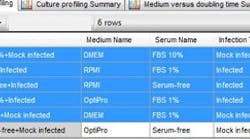When Merck Research Laboratories (MRL) identified biologics as an area of increasing focus and strategic growth, it also noted a gap in the ability of existing enabling technologies and processes to support the complex stages of biologics research and development. To solve this problem, MRL embarked on a collaborative effort with informatics provider PerkinElmer to build out the biologics functionality of the E-Notebook electronic laboratory notebook (ELN), application which is used by thousands of Merck employees.
Merck had surveyed its options and decided it could leverage its substantial investment in the E-Notebook platform, particularly the BioAssay structured results management module, by collaborating on new development, not customizations, to the software. Under the collaborative agreement, PerkinElmer would build out its E-Notebook solution as an integrated platform to support Merck’s biologics workflows.
“We wanted a commercial product with support behind it,” said Dermot BarryWalsh, executive director for Vaccine/Biologics R&D at MRL. “We did not want substantial custom code that we would need to feed and care for. One of the key factors to the success of this process was PerkinElmer’s willingness to collaborate and respond to our needs to enhance a commercial, not custom, product.”
Merck also wanted to standardize on a solution, because it biologics researchers, some of whom came from the 2009 merger with Schering-Plough, were using a combination of spreadsheets, paper lab notebooks and the E-Notebook ELN, which had been introduced as paper replacement. Merck wanted the solution to be integrated, so that its users could search, access and share biologics data and manage tasks. Expanding E-Notebook’s functionality would provide MRL with a standard solution with integrated biologics-specific workflow capabilities, such as attached data structure, taxonomy or data models. Such a structure would enable results to be searched and shared.
Merck and PerkinElmer worked jointly to identify requirements to develop the BioAssay module for structured data, results, sample tracking and management capabilities for a collaborative biologics environment. According to Barry Walsh and Mark Jankowski, Merck’s director for application services, MRL sought benefits from this collaborative development on two different levels. First, MRL scientists would be able to capture data with content. This would enable them to perform sequential and comparative analyses throughout a product’s life cycle. Second, MRL lab managers and others would be able to assess productivity, cycle time, capacity understanding and perform full product life cycle analyses.
BarryWalsh said the structured database let MRL “more easily access and analyze the data than if it’s just attached as an Excel spreadsheet.”
EXPANDING FUNCTIONALITY
To meet MRL’s growing biologics requirements, PerkinElmer first evaluated the BioAssay and RDLIMS modules in a so-called sandbox environment, which allowed them to assess new functionality and determine if the proposed solutions fit the purpose. After the proof of concept was completed and the new functionality was built out, the enterprise solution was tested in a production pilot. Merck then rolled out the biologics functionality, for the BioAssay and sample tracking and management solutions, to select users at Merck’s Vaccines Development, Biologics Discovery and Biologics Development areas. Researchers in the In Vivo data management within Merck’s Discovery and Preclinical R&D groups also received the E-Notebook BioAssay module for use in data collection, analysis and reporting. Additionally, because of its prevalence through MRL, E-Notebook’s enhanced biologics functionality is accessible to various functional groups, based on roles and responsibilities via the security system within the ELN.
Initially, MRL focused on productivity gains from its collaborative development project. Enhancements to the biologics functionality of E-Notebook would eliminate manual data manipulation, overhead and lost data or information that had occurred in the preexisting environment. Merck’s Jankowski said the company anticipates performance enhancements as well. This would come from aggregating, analyzing and reporting data and by reducing low-value experiments due to better visibility of existing data. He noted that measuring these improvements requires more data. At this stage of deployment, he said workflow enhancements are being realized. Manual processes can now be performed by the E-Notebook’s sample tracking and management functionality, saving time and reducing errors. Samples generated by one group and processed by another can now be automatically tracked and results automatically reported.
Merck and PerkinElmer plan further collaboration, to address additional, iterative development of the enhanced E-Notebook BioAssay module as new requirements emerge from subsequent waves of deployment. The companies will address priority needs, focusing on usability and flexibility. Merck is particularly interested in developing the BioAssay module for use by external partners so that outsourced work can be performed within BioAssay and integrated seamlessly with Merck’s system.



